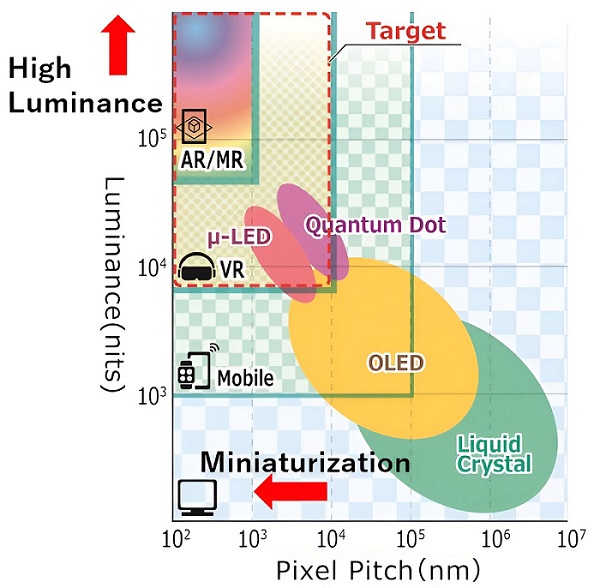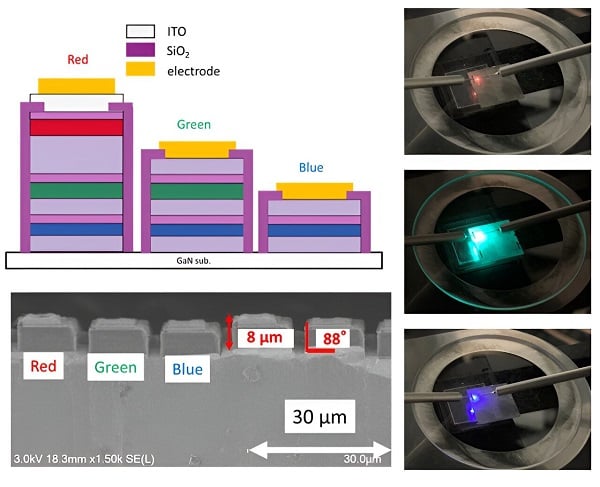
Micro-LEDs Heighten Color and Definition for Immersive Displays
NAGOYA, Japan, Sept. 14, 2023 — High resolution and high definition are key to delivering a realistic visual experience in augmented reality (AR) and other immersive technologies. Inexpensive micro-LEDs that enable full-color imaging at high resolution could help immersive displays reach their full potential.
A design for gallium indium nitride (GaInN)-based micro-LEDs, developed by researchers at Meijo University and King Abdullah University of Science and Technology (KAUST), could play a role in advancing metaverse applications to the next level by improving the definition, resolution, and saturation of their colors.

Display trends and targets of the micro-LED array technology. Courtesy of Motoaki Iwaya/Meijo University.
GaInN semiconductors are used to build high-performance LEDs that provide the resolution, detail, and color breadth needed to achieve highly realistic displays. Constructing GaInN-based LEDs as a single unit on the same substrate is essential for obtaining optimum performance, and this is what the researchers set out to do.
The researchers fabricated monolithic, stacked, RGB micro-LED arrays using GaInN-based tunnel junctions to connect each LED on the same wafer. The RGB micro-LEDs were stacked on single wafers through crystal growth.
They stacked the blue and green LED structures with GaInN-based tunnel junctions, and then stacked the red LEDs on top of the blue and green LEDs. A blue GaInN superlattice and GaInN single-quantum well, inserted between an n-type GaN layer and the active layer in the red LED structure, helped improve the emission efficiency of the red LEDs.
“We sequentially stacked blue, green, and red micro-LED arrays — connected by tunnel junctions, based on the quantum mechanical principle of electron transport through a thin insulating layer — onto the same wafer,” said Motoaki Iwaya, a professor at Meijo University.
The wafers were fabricated on gallium nitride (GaN) substrates using the metal-organic vapor phase epitaxy method. The micro-LED arrays were built using metal enhanced substrate adhesion architectures. The micro-LEDs were fabricated using existing manufacturing methods.
The GaInN-based micro-LED arrays achieved a pixel density of 330 pixels per inch. The researchers tested the micro-LED arrays at room temperature (approximately 26 °C) and direct current. Each micro-LED emitted blue, green, and red with peak wavelengths of 486, 514, and 604 nm, respectively, at a current density of 50 A/cm−2.
The researchers said that the full width at half maximum of the emission spectrum was narrow enough to emit red, blue, and green light, and more than enough to distinguish between the red, blue, and green.

The demonstrated device structure and luminescence. Courtesy of Motoaki Iwaya/Meijo University.
“There were a few extraneous emitted wavelengths, and the red and blue emissions were substantially less than the green emission — both attributable to damage during device fabrication,” said Kazuhiro Ohkawa, a professor at KAUST. “Optimizing the crystal growth conditions should ameliorate these defects.”
The team’s approach to fabricating micro-LED arrays minimizes the typical limitations previously encountered with LEDs that are based on GaInN technology. The results of the study could lead to monolithic, full-color, GaInN-based micro-LED arrays that provide high-definition, high-resolution, highly saturated, and highly realistic displays for metaverse applications.
Researcher Daisuke Iida said that preparing the devices on cheap sapphire substrates would be necessary for practical use. “Such work is underway in our laboratory,” he said. “We believe our work is an important step toward realistic, immersive visual experiences that require ultrahigh brightness and definition.”
The research was published in Applied Physics Express (www.doi.org/10.35848/1882-0786/aced7c).
Published: September 2023